

Let’s begin this blog post by remembering embarrassing memories from our past. Remember when you called your teacher “mom” in kindergarten? Or that huge zit on your forehead on your first day of high school? Let’s have a look at a picture from a couple of years ago. Those clothes… those hideous clothes. Why did you think you’d rock those super tight pants forever? Well.. you’ve changed and so did those fashion trends. Trends also seem to change quite rapidly in other kinds of design. In this blogpost, I’ll walk you through 3 tips to modernize your handout design and improve an old print design to fit in the modern world. I’m using a recent redesign of a handout made for our mobile team as an example.
1. Go digital
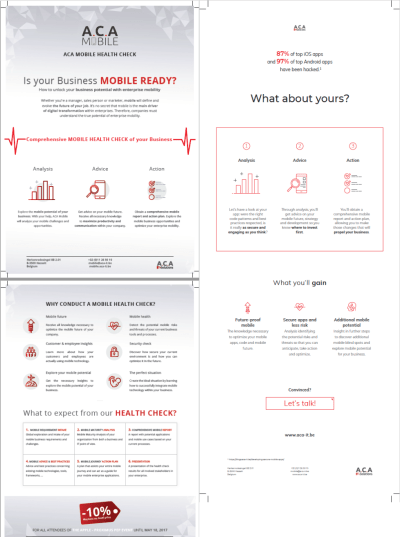
The biggest change in this redesign is that we’re actually stepping away from print and moving towards digital media, such as a PDF file. A couple of advantages go hand in hand here. You no longer have to worry about how you’re going to jam all your information on two A4 pages, since you aren’t limited to a certain page size. This gives you more freedom with both your structure and information placement. As you can see in our example (click the picture on the right), this results in a lighter design that’s much more enjoyable to read because of extra whitespace between sections.
Another big improvement is the ability to make use of links. You don’t have to write a full URL anymore, because you can just click on a shorter one or even add a button like you’re designing a webpage. Try adding links to logos or pictures. By doing this, you’re changing a completely static object into a link to even more information. Your handout is no longer limited to just the information on your two pages. Be careful you don’t forget to add links to anything that seems ‘clickable’ though. If your user tries to click on something that should’ve been a redirect to for example your website and it doesn’t work, you don’t make a good impression.
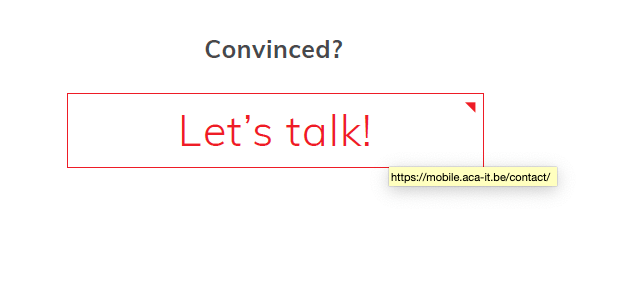
2. Add more whitespace!
First things first, whitespace doesn’t need to be ‘white’ space. Whitespace refers to empty breathing room in your design, not a white colour between design elements. Imagine getting a page to read and everything is cropped in the first half of the page. I’d rather gouge my eyes out than try to read that. Space out your information and use that empty space to improve the reader’s experience and even guide them to parts you want them to read. In other words, empty space makes your content more readable. When your focus is to inform your reader, readability is top priority.
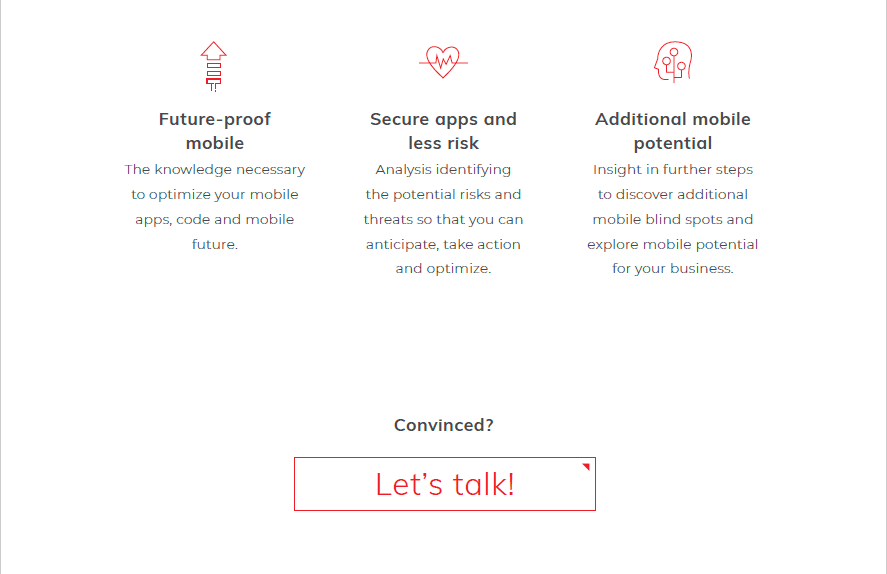
In our old design, we used an abstract background. Pictures or patterns can be used as whitespace but aren’t ideal if you’re going for a professional and clean look. We simply changed to a white background instead. This way, we structured our design in a couple of ‘information containers’. The whitespace makes sure each of those containers gets the focus it deserves. So don’t just read whitespace and see it as unused space. Think of whitespace as a guide for your reader.

3. Don't overdo it
You want to tell your audience something, so get to the point. Don’t try to over-explain and don’t use words you even barely know to sound smart. The same goes for showing pictures and using design elements. Nobody wants to scroll through 10 pictures which all show the same thing to find information they need. Say what you need to say and show what you need to show.
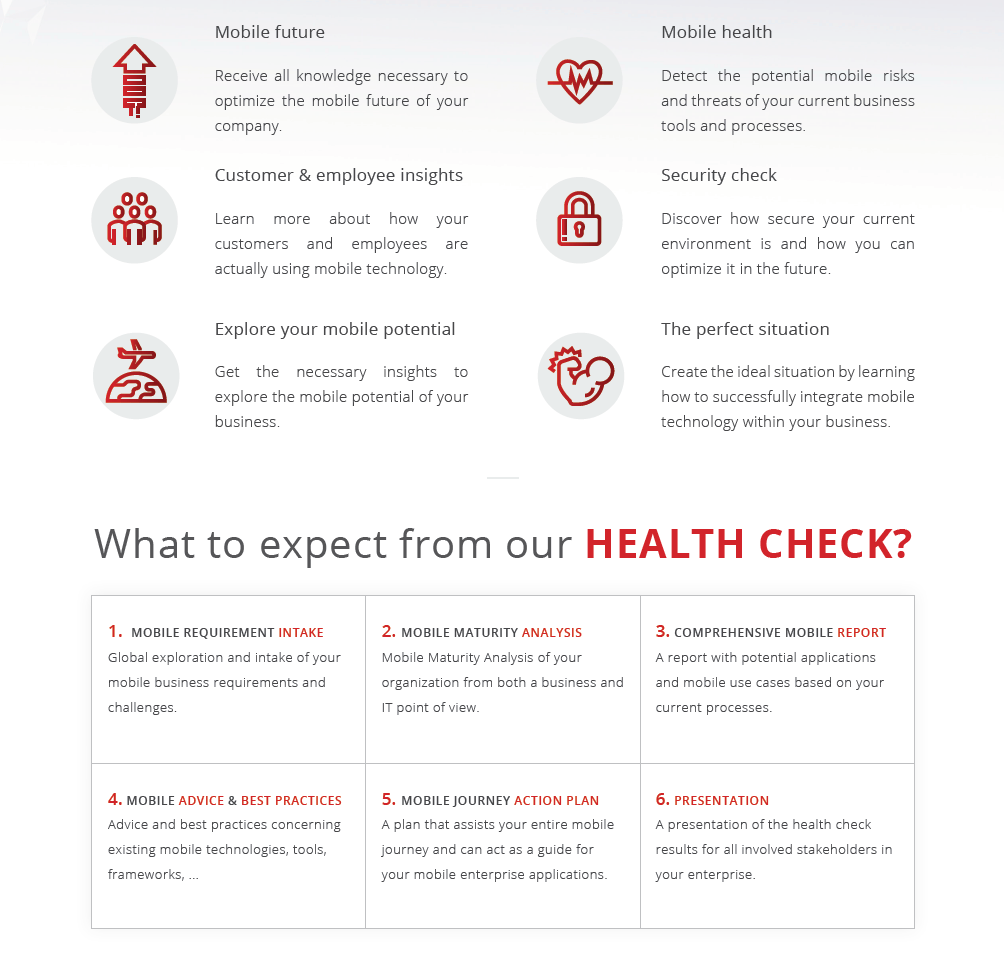
Also, try using a number instead of an icon when speaking about a certain percentage for example. People love numbers (just look at all those infographics floating around on the internet as proof). Try to have a nice balance between icons and percentages when designing something. Of course, there’s nothing wrong with using icons as a visual too. They can break your wall of text, make it more enjoyable to reed and keep the reader interested.
Last but not least, your design isn’t a child’s coloring book. Don’t use all of the crayons available! We went way overboard in our previous design. Now we’re only using red as our main color because it’s also the main color of ACA’s corporate identity. If you really want to use more color in your new design, be consistent. Don’t give your first title a blue color while giving your other titles a purple color. It’s pretty basic really, but often overlooked.
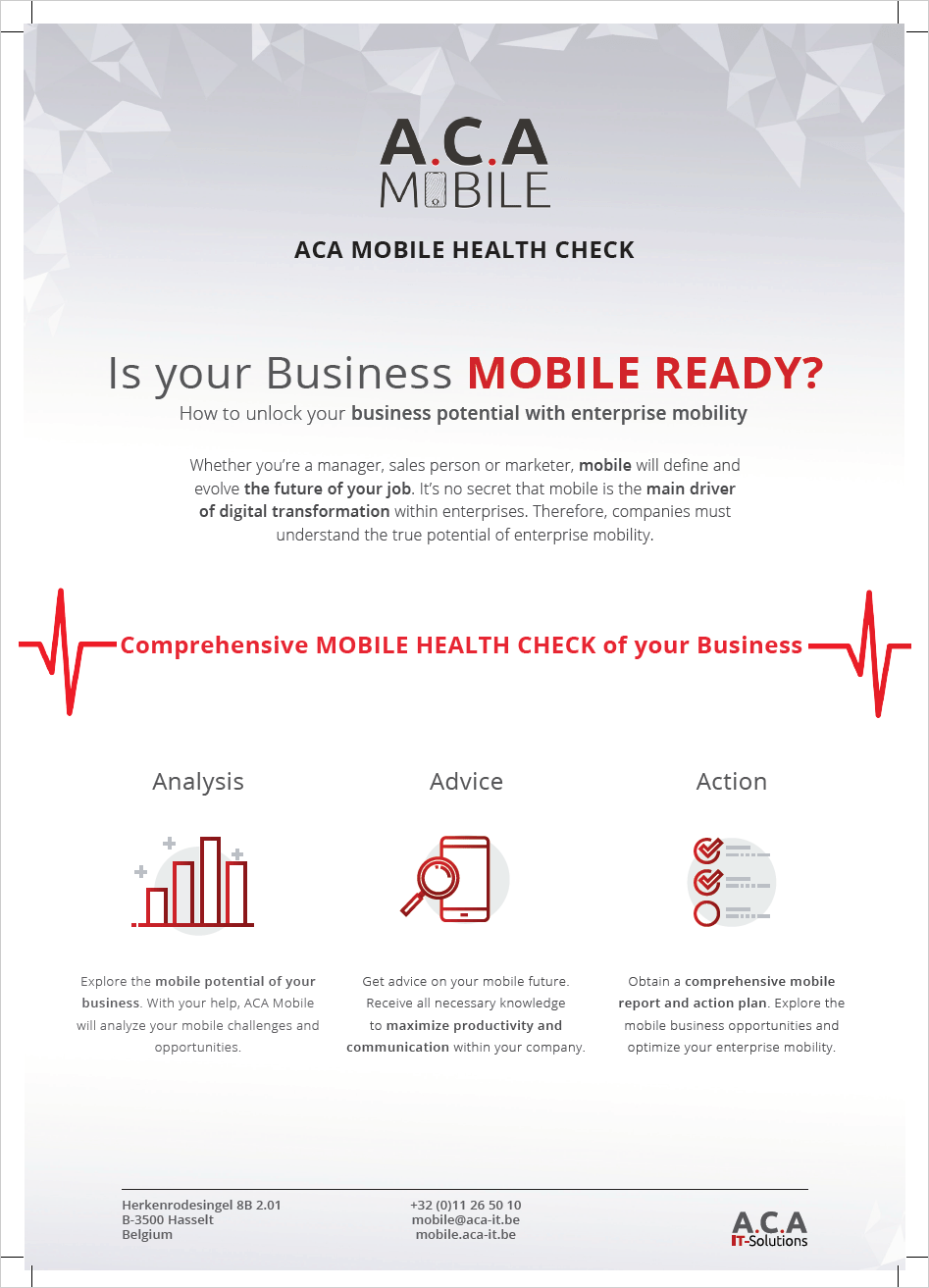
🚀 Takeaway
Print design isn’t exclusively for just print anymore in today’s digital world. If you want to update your previous print designs so they fit in our online lives as well, here are some things you should take into account:
- Forget strict page size limits.
- Include clickable links in your design. You can even add buttons like on a website.
- Use as much whitespace as you need to help your reader ‘breathe’ for a second and rest their eyes.
- Be brief!
- Include visuals, but stay consistent in your color palette.


What others have also read


Do you know that feeling when you wake up from a great night? That moment when you sip from your freshly made coffee? The feeling you get when you open your laptop to start your new awesome day… only to be thrown into the fiery pits of design hell when you read the latest email from one of your clients: “The design is nice, but can you make it pop?” Goodbye awesome day, hello misery. Tired of getting vague feedback like this? Same here! Before we get to the steps of dealing with vague feedback, you should know the difference between constructive and vague feedback. If someone gives you comments in a detailed manner about what they like and don’t like, that’s constructive feedback. Perhaps you don’t agree with everything they say, but you can have a conversation and improve your design. Now vague feedback, that’s another story… “make it pop”, “can you add premium effects” or “this doesn’t look sexy enough” is feedback we all hate. You don’t know what the client means, so there’s no way you can improve your design. This is vague feedback and it can seriously ruin your day! But if you try the following 5 steps, it’ll help you deal with these kinds of situations. 1. Take a breath and expel your anger. Never respond immediately with an angry or aggressive email defending your work like it’s a masterpiece worth millions. Stand up for a minute, take a breath. Think about puppies and kittens. Listen to something relaxing . When you answer to vague feedback in an aggressive or defensive way, you’ll probably get a likewise answer with feedback that’s even weirder. Or in the worst case, they’ll search for another designer. This isn’t the outcome you want. The thing you want is feedback you can work with. So don’t take the vagueness personal and answer in a polite and clear way. This way your client will realise you take the project seriously and want to deliver a design you’re both happy with. 2. Ask clarifying questions You can’t improve your designs with feedback like ‘make it pop, premium or sexy’. So try to understand what your clients really wants to tell you by asking clarifying questions. For example, if you want to know what the meaning is of ‘make it pop’ you could ask for an example of a logo they think ‘pops’. Or ask whether they mean they just want brighter colors. The more specific you are with your question, the more detailed the answer hopefully will be. Keep in mind this doesn’t mean you’re agreeing with your client’s feedback. It’s just about understanding what they want. So be patient and ask enough questions. If you don’t get the answers you want, try having a meeting or video call. 3. Give them new options Build on the answers of your previously asked questions and present your client with some options about which changes you can make to the design. Search for examples and make sure they understand exactly what you’re trying to communicate. Tell them for example that you can change the colors and then show them a couple of color schemes so they can actively help choosing. While you’re giving these options, you’ll probably get feedback out of your client they didn’t think of before. 4. Motivate yourself Before we move on to the final step, let’s lift your spirits . Don’t be sad about how your day started. Remember that coffee you had earlier? Have another one and let’s move on with our process of dealing with vague feedback. We understand your mood can change when you really need to hunt for the opinion of people who don’t express themselves clearly in their first email. But use this as an opportunity to improve yourself. Let this be your motivation! Maybe you’ll learn a new skill by moving outside of your comfort zone? Often, after actively trying to receive useful feedback, you come up with new ideas on your own, for your current project or a whole other one. Feedback can bruise your ego, especially if it’s oddly communicated, but it can just as easily help you stay grounded. Use feedback to improve and motivate yourself! 5. Prevent vague feedback in the future Experiences like these can help you improve yourself, but they can also improve your design process. Go back to the beginning and try understanding why the person gave you such vague feedback. Maybe you just sent your ‘design_v1.pdf’ with the question “What do you think”? Perhaps you started designing too soon, without asking questions first? Try to use step 2 and 3 as a prevention tool in the future. Ask clarifying questions and give them options about what the outcome might look like. When you ask for feedback, send along some questions like “What do you think about the font?” or “I think there isn’t enough whitespace, what do you think?” This will encourage the person on the other end to answer in more detail. We know this kind of feedback will always be in our lives, and it will continue to annoy designers all over the world. But let’s try to handle it in a positive way so the client gets the design they want, and you get an awesome experience creating something.
Read moreWant to dive deeper into this topic?
Get in touch with our experts today. They are happy to help!

Want to dive deeper into this topic?
Get in touch with our experts today. They are happy to help!

Want to dive deeper into this topic?
Get in touch with our experts today. They are happy to help!

Want to dive deeper into this topic?
Get in touch with our experts today. They are happy to help!

